| Listing 1 - 10 of 39 | << page >> |
Sort by
|
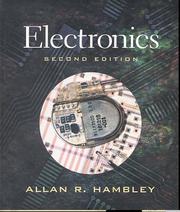
ISBN: 0136919820 9780136919827 Year: 2000 Publisher: Upper Saddle River: Prentice Hall,
Abstract | Keywords | Export | Availability | Bookmark
 Loading...
Loading...Choose an application
- Reference Manager
- EndNote
- RefWorks (Direct export to RefWorks)

ISBN: 0471293660 Year: 2000 Publisher: New York (N.Y.) : Wiley,
Abstract | Keywords | Export | Availability | Bookmark
 Loading...
Loading...Choose an application
- Reference Manager
- EndNote
- RefWorks (Direct export to RefWorks)
Computer-aided design --- Electric network analysis --- -Semiconductors --- -Interface circuits --- -Circuits, Interface --- Electronic circuits --- Logic circuits --- Crystalline semiconductors --- Semi-conductors --- Semiconducting materials --- Semiconductor devices --- Crystals --- Electrical engineering --- Electronics --- Solid state electronics --- Electric circuit analysis --- Electric networks --- CAD (Computer-aided design) --- Computer-assisted design --- Computer-aided engineering --- Design --- Data processing --- Junctions --- -Computer simulation --- Computer simulation --- Materials --- Computer-aided design. --- Interface circuits --- Semiconductors --- Data processing. --- Computer simulation. --- -Data processing --- -CAD (Computer-aided design) --- Circuits, Interface --- Junctions&delete& --- Network analysis, Electric --- System analysis

ISBN: 0792380134 1441950184 147572649X Year: 1997 Publisher: Boston Kluwer
Abstract | Keywords | Export | Availability | Bookmark
 Loading...
Loading...Choose an application
- Reference Manager
- EndNote
- RefWorks (Direct export to RefWorks)
Introduction to Hardware-Software Co-Design presents a number of issues of fundamental importance for the design of integrated hardware software products such as embedded, communication, and multimedia systems. This book is a comprehensive introduction to the fundamentals of hardware/software co-design. Co-design is still a new field but one which has substantially matured over the past few years. This book, written by leading international experts, covers all the major topics including: fundamental issues in co-design; hardware/software co-synthesis algorithms; prototyping and emulation; target architectures; compiler techniques; specification and verification; system-level specification. Special chapters describe in detail several leading-edge co-design systems including Cosyma, LYCOS, and Cosmos. Introduction to Hardware-Software Co-Design contains sufficient material for use by teachers and students in an advanced course of hardware/software co-design. It also contains extensive explanation of the fundamental concepts of the subject and the necessary background to bring practitioners up-to-date on this increasingly important topic.
system-on-chip design --- Hardware/software co-design --- Computer-aided design. --- System design. --- Systems engineering. --- Computer-aided design --- System design --- Systems engineering --- Engineering systems --- System engineering --- Design, System --- Systems design --- CAD (Computer-aided design) --- Computer-assisted design --- Design and construction --- Engineering --- Industrial engineering --- System analysis --- Electronic data processing --- Computer-aided engineering --- Design --- Electronic circuits. --- Computer-aided engineering. --- Electrical engineering. --- Software engineering. --- Circuits and Systems. --- Computer-Aided Engineering (CAD, CAE) and Design. --- Electrical Engineering. --- Software Engineering/Programming and Operating Systems. --- Computer software engineering --- Electric engineering --- CAE --- Electron-tube circuits --- Electric circuits --- Electron tubes --- Electronics --- Data processing
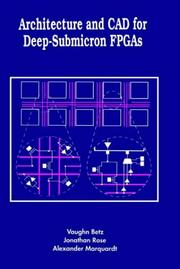
ISBN: 0792384601 1461373425 1461551455 Year: 1999 Publisher: Boston (Mass.) : Kluwer academic,
Abstract | Keywords | Export | Availability | Bookmark
 Loading...
Loading...Choose an application
- Reference Manager
- EndNote
- RefWorks (Direct export to RefWorks)
Since their introduction in 1984, Field-Programmable Gate Arrays (FPGAs) have become one of the most popular implementation media for digital circuits and have grown into a $2 billion per year industry. As process geometries have shrunk into the deep-submicron region, the logic capacity of FPGAs has greatly increased, making FPGAs a viable implementation alternative for larger and larger designs. To make the best use of these new deep-submicron processes, one must re-design one's FPGAs and Computer- Aided Design (CAD) tools. Architecture and CAD for Deep-Submicron FPGAs addresses several key issues in the design of high-performance FPGA architectures and CAD tools, with particular emphasis on issues that are important for FPGAs implemented in deep-submicron processes. Three factors combine to determine the performance of an FPGA: the quality of the CAD tools used to map circuits into the FPGA, the quality of the FPGA architecture, and the electrical (i.e. transistor-level) design of the FPGA. Architecture and CAD for Deep-Submicron FPGAs examines all three of these issues in concert. In order to investigate the quality of different FPGA architectures, one needs CAD tools capable of automatically implementing circuits in each FPGA architecture of interest. Once a circuit has been implemented in an FPGA architecture, one next needs accurate area and delay models to evaluate the quality (speed achieved, area required) of the circuit implementation in the FPGA architecture under test. This book therefore has three major foci: the development of a high-quality and highly flexible CAD infrastructure, the creation of accurate area and delay models for FPGAs, and the study of several important FPGA architectural issues. Architecture and CAD for Deep-Submicron FPGAs is an essential reference for researchers, professionals and students interested in FPGAs.
-Programmable array logic --- CAD computer aided design --- FPGA field programmable gate arrays --- RAM random access memory --- SRAM static random access memory --- Field programmable gate arrays --- Programmable array logic --- 681.31 --- ontwerpen --- 681.3*B7 --- 681.3*B7 Integrated circuits (Hardware) --- Integrated circuits (Hardware) --- Array logic, Programmable --- Digital electronics --- Microprocessors --- Programmable logic devices --- Field programmable logic arrays --- FPGAs --- Gate array circuits --- Computer-aided design --- Computerarchitectuur. Informaticahardware --- Programmable array logic. --- Computer-aided design. --- Electronic circuits. --- Electrical engineering. --- Computer-aided engineering. --- Circuits and Systems. --- Electrical Engineering. --- Computer-Aided Engineering (CAD, CAE) and Design. --- CAE --- Engineering --- Electric engineering --- Electron-tube circuits --- Electric circuits --- Electron tubes --- Electronics --- Data processing
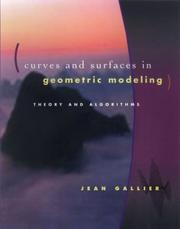
ISBN: 1558605991 Year: 2000 Publisher: San Francisco (Calif.) : Morgan Kaufmann,
Abstract | Keywords | Export | Availability | Bookmark
 Loading...
Loading...Choose an application
- Reference Manager
- EndNote
- RefWorks (Direct export to RefWorks)
Artificial intelligence. Robotics. Simulation. Graphics --- Curves, Algebraic --- Surfaces --- Computer-aided design --- Courbes algébriques --- Conception assistée par ordinateur --- Data processing --- Informatique --- -Surfaces --- -Curved surfaces --- Geometry --- Shapes --- Algebraic curves --- Algebraic varieties --- CAD (Computer-aided design) --- Computer-assisted design --- Computer-aided engineering --- Design --- Computer-aided design. --- Data processing. --- -Data processing --- Courbes algébriques --- Conception assistée par ordinateur --- Curved surfaces
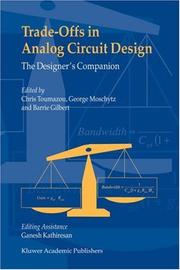
ISBN: 9781402070372 1402070373 9780306476730 9786610201587 1280201584 0306476738 Year: 2002 Publisher: Boston: Kluwer,
Abstract | Keywords | Export | Availability | Bookmark
 Loading...
Loading...Choose an application
- Reference Manager
- EndNote
- RefWorks (Direct export to RefWorks)
As the frequency of communication systems increases and the dimensions of transistors are reduced, more and more stringent performance requirements are placed on analog circuits. This is a trend that is bound to continue for the foreseeable future and while it does, understanding performance trade-offs will constitute a vital part of the analog design process. It is the insight and intuition obtained from a fundamental understanding of performance conflicts and trade-offs, that ultimately provides the designer with the basic tools necessary for effective and creative analog design. Trade-offs in Analog Circuit Design, which is devoted to the understanding of trade-offs in analog design, is quite unique in that it draws together fundamental material from, and identifies interrelationships within, a number of key analog circuits. The book covers ten subject areas: Design methodology, Technology, General Performance, Filters, Switched Circuits, Oscillators, Data Converters, Transceivers, Neural Processing, and Analog CAD. Within these subject areas it deals with a wide diversity of trade-offs ranging from frequency-dynamic range and power, gain-bandwidth, speed-dynamic range and phase noise, to tradeoffs in design for manufacture and IC layout. The book has by far transcended its original scope and has become both a designer's companion as well as a graduate textbook. An important feature of this book is that it promotes an intuitive approach to understanding analog circuits by explaining fundamental relationships and, in many cases, providing practical illustrative examples to demonstrate the inherent basic interrelationships and trade-offs. Trade-offs in Analog Circuit Design draws together 34 contributions from some of the world's most eminent analog circuits-and-systems designers to provide, for the first time, a comprehensive text devoted to a very important and timely approach to analog circuit design.
Electronic circuit design --- Engineering economy --- Circuits électroniques --- Décision économique, prise de --- Calcul --- Computer aided design. --- Computer engineering. --- Electronic circuit design. --- Engineering. --- Engineering economy. --- Electrical Engineering --- Electrical & Computer Engineering --- Engineering & Applied Sciences --- Computer-aided engineering. --- Electrical engineering. --- Electrical Engineering. --- Computer-Aided Engineering (CAD, CAE) and Design. --- Economy, Engineering --- Engineering economics --- Industrial engineering --- Electronic circuits --- Design --- CAE --- Engineering --- Electric engineering --- Data processing
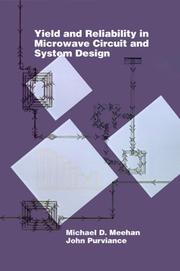
ISBN: 0890065276 Year: 1993 Publisher: Boston (Mass.) : Artech house,
Abstract | Keywords | Export | Availability | Bookmark
 Loading...
Loading...Choose an application
- Reference Manager
- EndNote
- RefWorks (Direct export to RefWorks)
Computer-aided design --- Engineering design --- -Microwave integrated circuits --- -Integrated circuits --- Microwave circuits --- Design, Engineering --- Engineering --- Industrial design --- Strains and stresses --- CAD (Computer-aided design) --- Computer-assisted design --- Computer-aided engineering --- Design --- Statistical methods --- Design and construction --- Computer-aided design. --- Microwave integrated circuits --- Statistical methods. --- -Statistical methods --- Design and construction&delete& --- Integrated circuits
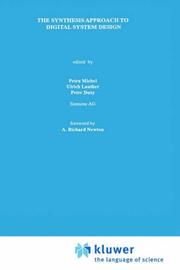
ISBN: 0792391993 1461366151 1461536324 Year: 1992 Publisher: Boston Kluwer
Abstract | Keywords | Export | Availability | Bookmark
 Loading...
Loading...Choose an application
- Reference Manager
- EndNote
- RefWorks (Direct export to RefWorks)
Computer-aided design --- Electronic circuit design --- -Digital electronics --- -Digital circuits --- Digital techniques (Electronics) --- Electronic systems --- Electronics --- Electronic circuits --- CAD (Computer-aided design) --- Computer-assisted design --- Computer-aided engineering --- Design --- Data processing --- Computer-aided design. --- Digital electronics --- Data processing. --- -Data processing --- Digital circuits
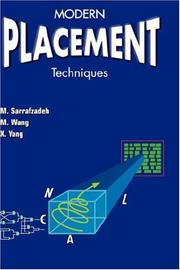
ISBN: 140207221X 1441953094 1475737815 Year: 2002 Publisher: Boston Kluwer
Abstract | Keywords | Export | Availability | Bookmark
 Loading...
Loading...Choose an application
- Reference Manager
- EndNote
- RefWorks (Direct export to RefWorks)
Modern Placement Techniques explains physical design and VLSI/CAD placement to the professional engineer and engineering student. Along with explaining the problems that are associated with placement, the book gives an overview of existing placement algorithms, techniques and methodologies. Modern Placement Techniques emphasizes recent advances in addressing the placement problem, including congestion-driven, timing driven, mixed macro-cell and standard cell placement. The book presents the Dragon placement tool, with detailed algorithm descriptions for wire length, congestion and timing optimization. Placement benchmarks and results produced by Dragon are explained in detail.
Integrated circuit layout. --- Integrated circuit layout --- Layout, Integrated circuit --- Integrated circuits --- Design and construction --- Electronic circuits. --- Electrical engineering. --- Computer-aided engineering. --- Circuits and Systems. --- Electrical Engineering. --- Computer-Aided Engineering (CAD, CAE) and Design. --- CAE --- Engineering --- Electric engineering --- Electron-tube circuits --- Electric circuits --- Electron tubes --- Electronics --- Data processing
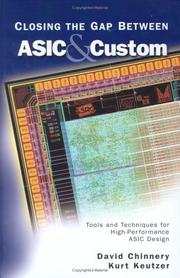
ISBN: 1402071132 0306478234 Year: 2004 Publisher: New York : Kluwer Academic Publishers,
Abstract | Keywords | Export | Availability | Bookmark
 Loading...
Loading...Choose an application
- Reference Manager
- EndNote
- RefWorks (Direct export to RefWorks)
by Kurt Keutzer Those looking for a quick overview of the book should fast-forward to the Introduction in Chapter 1. What follows is a personal account of the creation of this book. The challenge from Earl Killian, formerly an architect of the MIPS processors and at that time Chief Architect at Tensilica, was to explain the significant performance gap between ASICs and custom circuits designed in the same process generation. The relevance of the challenge was amplified shortly thereafter by Andy Bechtolsheim, founder of Sun Microsystems and ubiquitous investor in the EDA industry. At a dinner talk at the 1999 International Symposium on Physical Design, Andy stated that the greatest near-term opportunity in CAD was to develop tools to bring the performance of ASIC circuits closer to that of custom designs. There seemed to be some synchronicity that two individuals so different in concern and character would be pre-occupied with the same problem. Intrigued by Earl and Andy’s comments, the game was afoot. Earl Killian and other veterans of microprocessor design were helpful with clues as to the sources of the performance discrepancy: layout, circuit design, clocking methodology, and dynamic logic. I soon realized that I needed help in tracking down clues. Only at a wonderful institution like the University of California at Berkeley could I so easily commandeer an ab- bodied graduate student like David Chinnery with a knowledge of architecture, circuits, computer-aided design and algorithms.
Application specific integrated circuits --- ASICs (Integrated circuits) --- Electronic circuits. --- Electrical engineering. --- Computer-aided engineering. --- Circuits and Systems. --- Electrical Engineering. --- Computer-Aided Engineering (CAD, CAE) and Design. --- Integrated circuits --- CAE --- Engineering --- Electric engineering --- Electron-tube circuits --- Electric circuits --- Electron tubes --- Electronics --- Data processing --- Application-specific integrated circuits.
| Listing 1 - 10 of 39 | << page >> |
Sort by
|

 Search
Search Feedback
Feedback About UniCat
About UniCat  Help
Help News
News